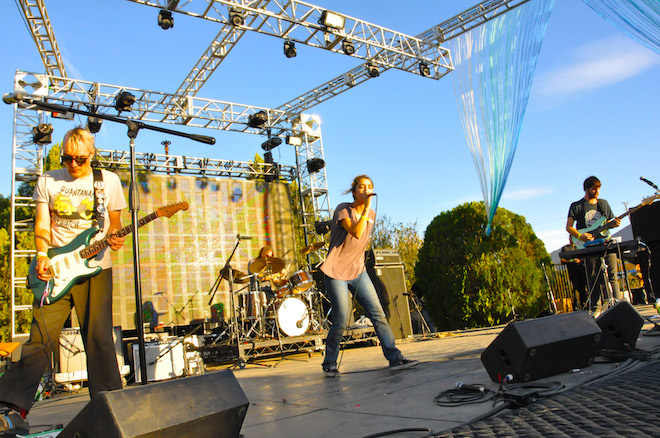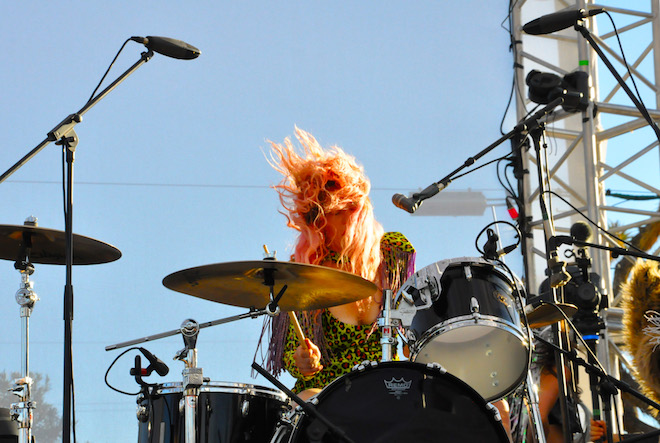A sun-drenched gathering in the form of a pysch-rock festival took place in the high desert landscape of Joshua Tree, California last month. Set in accordance with the October full moon, several thousand visitors congregated to celebrate music and art in the unique setting of The Institute of Mentalphysics – a mediation retreat set up in 1941 in Yucca Valley by Edwin John Dingle, known as Ding Le Mei to his many followers. The organisers behind Desert Daze are husband and wife team Phil Perrone and Julie Edwards of Moonblock – an artist driven production company based in Los Angeles – both of whom perform with their bands at the festival. We spoke a little about their DIY vision for Desert Daze.
Can you tell us about the history of Desert Daze, how did it start? Who are the team behind it?
Desert Daze started in 2012 because a roadhouse asked us to throw three parties during the double weekend of Coachella. We decided to throw 11 parties. The team are my closest family and friends – my wife, my friends, former bandmates, current bandmates, etc. We’re a family restaurant basically.

How have things progressed since the beginning? What are the major changes?
With each year, more and more people contribute and collaborate with it. We started with 13 people doing every job there is on a festival production – now there are 208. We used to use duct tape, now we use gaff.
How many revellers came to party at the first Desert Daze and how many have just joined you for 2016? Do you feel the numbers have changed things or has the general vibe stayed the same?
I think we had about 1,000 a day on that first one. Hard to say how many came out to 2016. It’s several thousand more, but still a very comfortable amount for the space – and that’s the point. I think the vibe is pretty much where it needs to be. Probably a bit more exciting than it used to be, but still relaxed enough to feel like you belong there.

Where have you held the previous festivals? Is Desert Daze nomadic or is the Institute of Mentalphysics the new annual home for you guys?
Desert Daze started in Desert Hot Springs, then Mecca, and now Joshua Tree. We’d love to make the Institute of Mentalphysics our permanent home. In a perfect world, we could lay down roots in Joshua Tree for the proper Desert Daze event and follow our nomadic spirit with a traveling version of the festival and other satellite events. We still need to do something in the Mojave.
Phil your band JjuuJjuu played the Saturday night whilst Julie, your band Deap Vally played an awesome gig on the Sunday afternoon, it looked like you guys were really having fun up there – it must feel pretty good to host and perform. Do you feel as musicians that you have a greater understanding of running the event? In terms of having a stronger empathy with the performers needs and the audience alike.
Being a touring musician definitely gives you a perspective on organizing an event and providing hospitality for both the artist and the fans. We hope to create an environment where both are super happy and comfortable. It’s conducive to having a good time.

Jenny Lee performs
You could tell us a little about how Desert Daze has grown from the psych-rock scene in California, if you feel that is the case or your background in it. Desert Daze definitely appeared to have a specific audience from one strong scene who were very much enjoying the weekend.
I think Desert Daze speaks to true music lovers. People who buy tickets early. Get in line early. Buy merch. Buy vinyl. People that LOVE live music. Live music is my religion, my philosophy, and I think Desert Daze is for people like that. We don’t just like psych or rock or world or ambient or weird or alternative or experimental music – we like all of that and more. If it’s honest, if it’s good, it has a place at Desert Daze.
The Institute of Mentalphysics is a meditation retreat set up in 1941, a maze of pathways and quiet gardens punctuated with modernist structures built using sacred geometry by architect Frank Lloyd Wright – quite a place to have a festival – Lloyd Wright believed in designing structures that were in harmony with their environment, is this something you feel Desert Daze promotes in it’s essence? Harmony in music, in art and in it’s environment.
Yes, it certainly does. Everything about this venue has really set the tone that we’ve always wanted Desert Daze to have. It’s the exact right place for this festival. It provides a space where the dreams we have for this festival can come true. There was an alchemic situation that happened with all of us getting together on that site under the full moon. Love was in the air. People got engaged. People got married. People made babies. It all happened. It was like we were all experiencing the same dream. And the site had a lot to do with it. The music had a lot to do with it. And the people had a lot to do with it. The chemistry of all factors involved made for an amazing reality that we all experienced as one. There was a real singular energetic thing going on. I hate to sound hippie dippy, but it felt scientific at the time and still does.

We’re interested in the future of the music festival, it seems as with many things today people are keen to return to an older model of best practice, a return to a simpler existence perhaps – is this something you discuss? Early models of music festivals.
I don’t know what early music festivals were like, exactly. But, I do know that we wanted ours to feel different and it does. We’ve achieved what we’ve been striving for, now we have to figure out how to simultaneously expand and maintain it at the same time. When I say expand, I don’t necessarily mean with capacity, I just mean in scope as far as art, installations, environs, and experience goes. I think we’ve only scratched the surface of what’s possible with the community of visual and installation artists we’ve magnetically connected to over the years. I look forward to building new and amazing things with these people. But, at the same time, I want to make sure we maintain the wild and free energy of it all. That’s the delicate balance we will now try to master as we move forward.
Can you talk us through some of the art installations around the site, did you have an overall vision for them? Who created them?
The art installations around the property are the result of many many hours of coordinating on the part of Mason Rothschild, our fearless art director. He assembled an amazing coterie of installations artists from around the country. Celeste Byers and Aaron Glasson built two installations – the transporter and the infinagon. Brad Hansen designed a life sized neon Desert Daze sign as well as an infinite neon mirror. Mieka Ginsburg and Prescott McCarthy built a beautiful vertical hanging shade design for the Block Stage, as well as a beautiful billowing white fabric shade for the audience at that stage and these amazing monolithic pillars with flowing white flags. They also brought a stellar pagoda. The team at Non Plus Ultra built the Cave of Far Gone Dreams where you could play bones and Duck Hunt. There was more. A lot more.
What were your personal highlights for 2016?
Having my 10 month old daughter there for the whole thing. Seeing Television play Marquee Moon under a full moon. Seeing everyone transform including myself. It was unreal. Surreal. Life changing for so many. Everything we wanted it to be and can’t wait to do it again next year.
What is your vision for Desert Daze 2017?
To continue the dream.



 Twitter
Twitter
 Tumblr
Tumblr
 YouTube
YouTube
 Facebook
Facebook
 Instagram
Instagram
